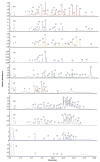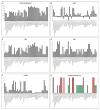Untargeted Chemical Profile, Antioxidant, and Enzyme Inhibition Activity of Physalis angulata L. from the Peruvian Amazon: A Contribution to the Validation of Its Pharmacological Potential
- PMID: 40227212
- PMCID: PMC11939355
- DOI: 10.3390/antiox14030246
Untargeted Chemical Profile, Antioxidant, and Enzyme Inhibition Activity of Physalis angulata L. from the Peruvian Amazon: A Contribution to the Validation of Its Pharmacological Potential
Abstract
Physalis angulata is a plant of great value in traditional medicine known for its content of bioactive compounds, such as physalins and withanolides, which possess diverse biological activities. In this study, the chemical profile, antioxidant activity, and enzyme inhibition capacity of aqueous and ethanolic extracts obtained from the root, stem, leaves, calyx, and fruits of P. angulata collected in Peru were evaluated. A total of forty-two compounds were detected in the extracts using UHPLC-ESI-QTOF-MS analysis. In vitro analyses revealed that leaf extracts contained the highest concentration of phenolic compounds, while leaf and fruit extracts showed the best results in FRAP, DPPH, and ABTS antioxidant tests; on the other hand, inhibition of AChE, BChE, α-glucosidase, and α-amylase enzymes was variable, but calyx and fruit extracts showed higher effectiveness. In silico analyses indicated that the compounds physagulin A, physagulin F, physagulide P, physalin B, and withaminimin showed stable interactions and favorable binding affinities with the catalytic sites of the enzymes studied. These results confirm the pharmacological potential of extracts and compounds derived from different organs of P. angulata, suggesting their promising use in treating diseases related to the central nervous system and metabolic syndrome.
Keywords: Physalis angulata; bioactive compounds; biological activity; extracts; therapeutic properties.
Conflict of interest statement
The authors declare no conflicts of interest.
Figures








Similar articles
-
Anti-inflammatory effects of three withanolides isolated from Physalis angulata L. in LPS-activated RAW 264.7 cells through blocking NF-κB signaling pathway.J Ethnopharmacol. 2021 Aug 10;276:114186. doi: 10.1016/j.jep.2021.114186. Epub 2021 May 4. J Ethnopharmacol. 2021. PMID: 33957208
-
Physalin pool from Physalis angulata L. leaves and physalin D inhibit P2X7 receptor function in vitro and acute lung injury in vivo.Biomed Pharmacother. 2021 Oct;142:112006. doi: 10.1016/j.biopha.2021.112006. Epub 2021 Aug 12. Biomed Pharmacother. 2021. PMID: 34392085
-
Chemical Composition Analysis, Cytotoxic, Antimicrobial and Antioxidant Activities of Physalis angulata L.: A Comparative Study of Leaves and Fruit.Molecules. 2022 Feb 22;27(5):1480. doi: 10.3390/molecules27051480. Molecules. 2022. PMID: 35268579 Free PMC article.
-
Metabolite Profiling by UPLC-MSE, NMR, and Antioxidant Properties of Amazonian Fruits: Mamey Apple (Mammea Americana), Camapu (Physalis Angulata), and Uxi (Endopleura Uchi).Molecules. 2020 Jan 15;25(2):342. doi: 10.3390/molecules25020342. Molecules. 2020. PMID: 31952109 Free PMC article.
-
Physalis alkekengi L. var. franchetii (Mast.) Makino: An ethnomedical, phytochemical and pharmacological review.J Ethnopharmacol. 2018 Jan 10;210:260-274. doi: 10.1016/j.jep.2017.08.022. Epub 2017 Aug 31. J Ethnopharmacol. 2018. PMID: 28838654 Review.
References
-
- Arruda J.C.C., Rocha N.C., Santos E.G., Ferreira L.G.B., Bello M.L., Penido C., Costa T.E.M.M., Santos J.A.A., Ribeiro I.M., Tomassini T.C.B., et al. Physalin pool from Physalis angulata L. leaves and physalin D inhibit P2X7 receptor function in vitro and acute lung injury in vivo. Biomed. Pharmacother. 2021;142:112006. doi: 10.1016/j.biopha.2021.112006. - DOI - PubMed
-
- Sandoval-Padilla I., Zamora-Tavares M.D.P., Ruiz-Sánchez E., Pérez-Alquicira J., Vargas-Ponce O. Characterization of the plastome of Physalis cordata and comparative analysis of eight species of Physalis sensu stricto. PhytoKeys. 2022;210:109–134. doi: 10.3897/phytokeys.210.85668. - DOI - PMC - PubMed
-
- Rengifo-Salgado E., Vargas-Arana G. Physalis angulata L. (bolsa mullaca): A review of its traditional uses, chemistry and pharmacology. Bol. Latinoam. Caribe Plantas Med. Aromát. 2013;12:431–445.
-
- da Silva Ramos C.A., Soares T.L., Santos N., Pelacani C.R. Influence of maturity stage on physical and chemical characteristics of fruit and physiological quality of seeds of Physalis angulata L. Sci. Hortic. 2021;284:110124. doi: 10.1016/j.scienta.2021.110124. - DOI
-
- Morales Saavedra J., Rodriguez F.A., Cabrera D., Sanchez C.V., Vargas-Ponce O. Agromorphological characterization of wild and weedy populations of Physalis angulata in Mexico. Sci. Hortic. 2019;246:86–94. doi: 10.1016/j.scienta.2018.10.055. - DOI
Grants and funding
LinkOut - more resources
Full Text Sources
Miscellaneous

